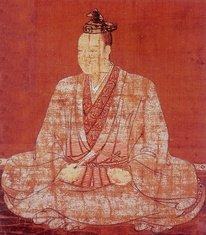|
No
|
Years Lived
|
Description
|
Answer
|
|
1
|
1528-1582
|
Retainer of Oda Nobunaga. He rebelled against Nobunaga in 1582, which led to Nobunaga's death in the incident at Honnō-ji. He then became shōgun for only 13 days, until he was defeated and executed by Toyotomi Hideyoshi.
|
Akechi Mitsuhide
|
|
2
|
1561-1602
|
Daimyō and retainer of Tokugawa Ieyasu. One of the Four Guardians of the Tokugawa. He participated in the Battle of Sekigahara, leading his unit known as the "Red Devils". His premature death in 1602 has been widely blamed on the wound he received in that battle.
|
Ii Naomasa
|
|
3
|
1553-1625
|
Daimyō from the Aki province. One of the members of the Council of Five Elders, taking the place of his uncle, Kobayakawa Takakage. He was the nominal commander of the Western Army in the Battle of Sekigahara, though he never participated in the battle itself.
|
Mōri Terumoto
|
|
4
|
1562-1611
|
Daimyō and general. Retainer of Toyotomi Hideyoshi. One of the Seven Spears of Shizugatake. In 1586, he was given Kumamoto Castle as his provincial residence. He participated in the Japanese invasion of Korea and later fought under Tokugawa Ieyasu in the Battle of Sekigahara.
|
Katō Kiyomasa
|
|
5
|
1556-1630
|
1st daimyō of the Tsu domain. He rose from relatively humble origins as an ashigaru (a foot soldier) to become a daimyō. During his lifetime he changed his feudal master seven times and worked for ten people, but in the end he rendered loyalty to Tokugawa Ieyasu, who became his last master.
|
Tōdō Takatora
|
|
6
|
1538-1599
|
Retainer of Oda Nobunaga. He served him from childhood as a page and later became one of his leading generals. After his death, he fought against Toyotomi Hideyoshi in the Battle of Shizugatake under the banner of Shibata Katsuie before eventually becoming Hideyoshi's vassal.
|
Maeda Toshiie
|
|
7
|
1530-1587
|
Daimyō of Bungo. One of the few daimyō to have converted to Christianity. He sent the Tenshō embassy to the Pope in Rome and the kings of Europe. He appealed to Toyotomi Hideyoshi to intervene in the Shimazu clan's conquest of Kyūshū.
|
Ōtomo Sōrin
|
|
8
|
1539-1599
|
Daimyō of Tosa. He conquered and ruled the island of Shikoku until he himself was defeated by a large army under the banner of Toyotomi Hideyoshi in his campaign to unite Japan.
|
Chōsokabe Motochika
|
|
9
|
1535-1619
|
Younger brother of the daimyō of Satsuma. A famous and skilled military commander. Greatly contributed to the unification of Kyūshū.
|
Shimazu Yoshihiro
|
|
10
|
1579-1632
|
2nd shōgun of the Edo shogunate. Succeeded as shōgun after his father, Ieyasu, stepped down from the shogunate in 1605.
|
Tokugawa Hidetada
|
|
11
|
1584-1645
|
Famous warrior and swordsman. Considered a kensei or sword-saint of Japan. Founder of the Niten Ichi-ryū school of swordsmanship. In his final years, he authored The Book of Five Rings, a text on kenjutsu and martial arts in general.
|
Miyamoto Musashi
|
|
12
|
c. 1575-1612
|
Famous swordsman. He went by the fighting name of Ganryū, which was also the name of the kenjutsu school he had founded. He is most remembered for his duel against (11), in which he was defeated and killed.
|
Sasaki Kojirō
|
|
13
|
1515-1571
|
Daimyō of Sagami. Based in Odawara Castle, he destroyed the Kantō branch of the Uesugi clan. However, he was later defeated by Uesugi Kenshin. He went into several conflicts with Takeda Shingen and the Takeda clan as well. He managed to make peace with both clans, letting his seventh son be adopted by childless Kenshin and marrying his daughter to Shingen's son.
|
Hōjō Ujiyasu
|
|
14
|
1593-1615(?)
|
Son and designated successor of Toyotomi Hideyoshi. He was also a grandson-in-law of Tokugawa Ieyasu, and his mother was the niece of Oda Nobunaga. He was defeated and thought to have perished in the Siege of Ōsaka, however his corpse was never found.
|
Toyotomi Hideyori
|
|
15
|
1494-1556
|
Daimyō from the Mino province. Father-in-law of Oda Nobunaga. He was also known as the Viper of Mino for his ruthless tactics. He was killed in battle by his own adopted son, Yoshitatsu, for allegedly naming Nobunaga as the Lord of Mino in his will.
|
Saitō Dōsan
|

